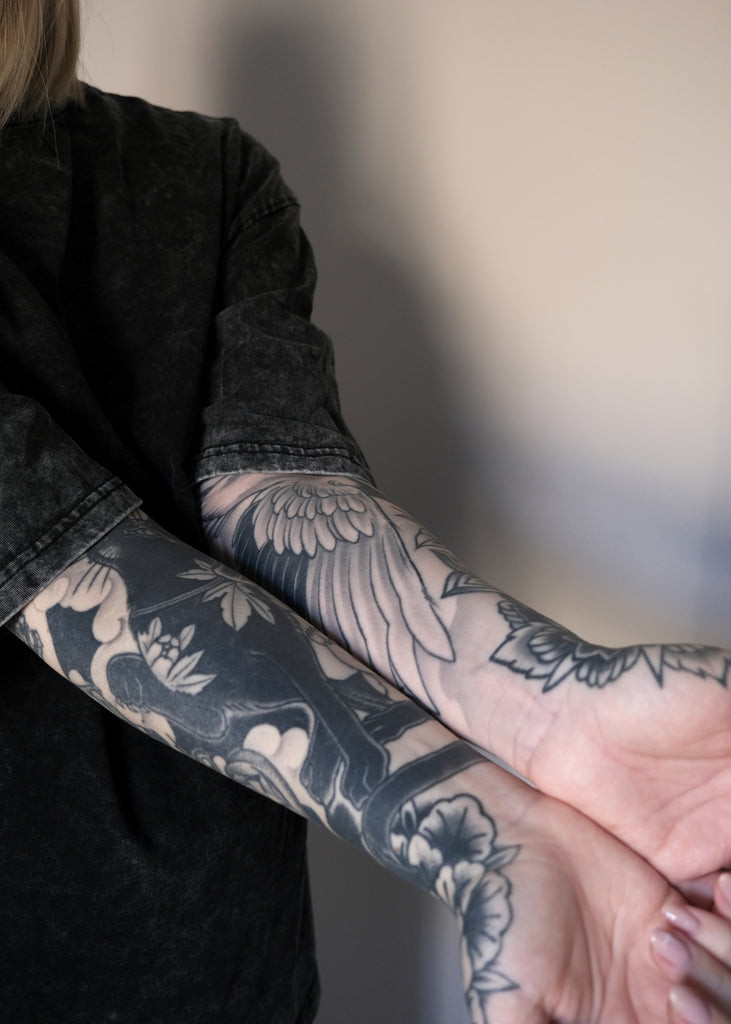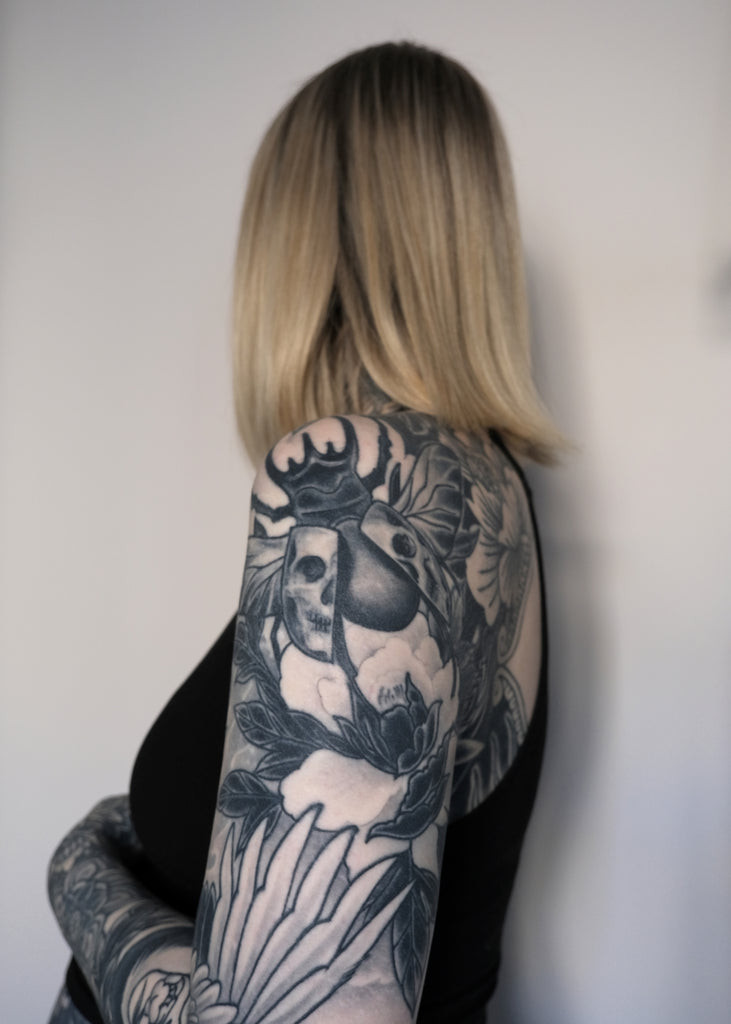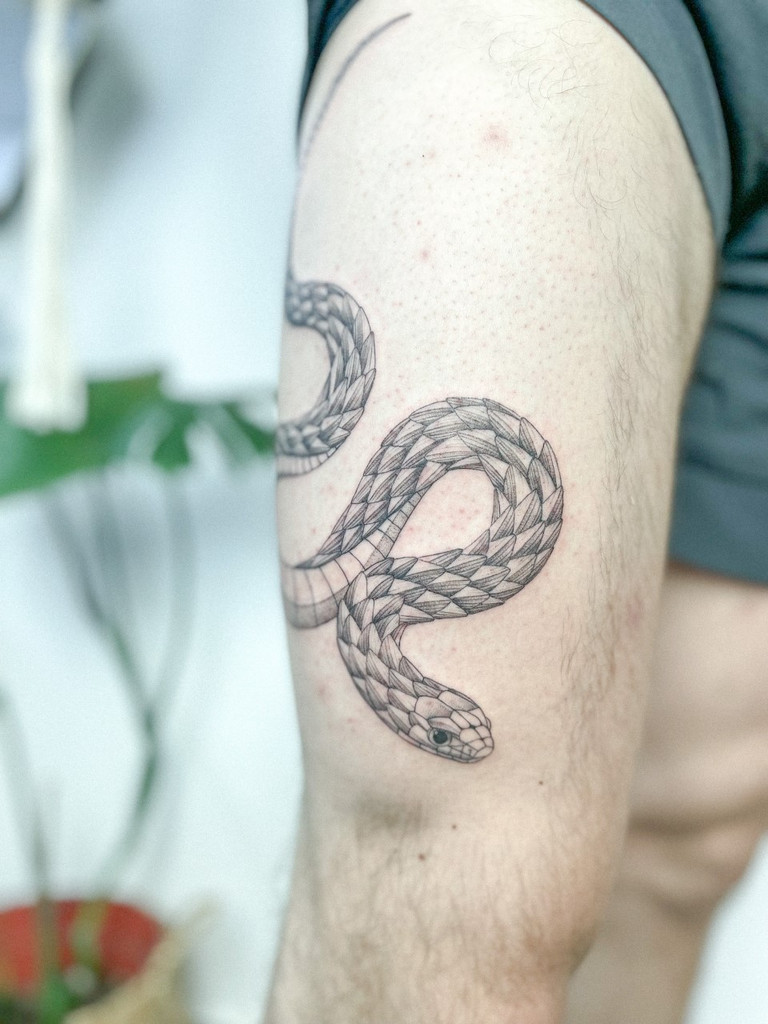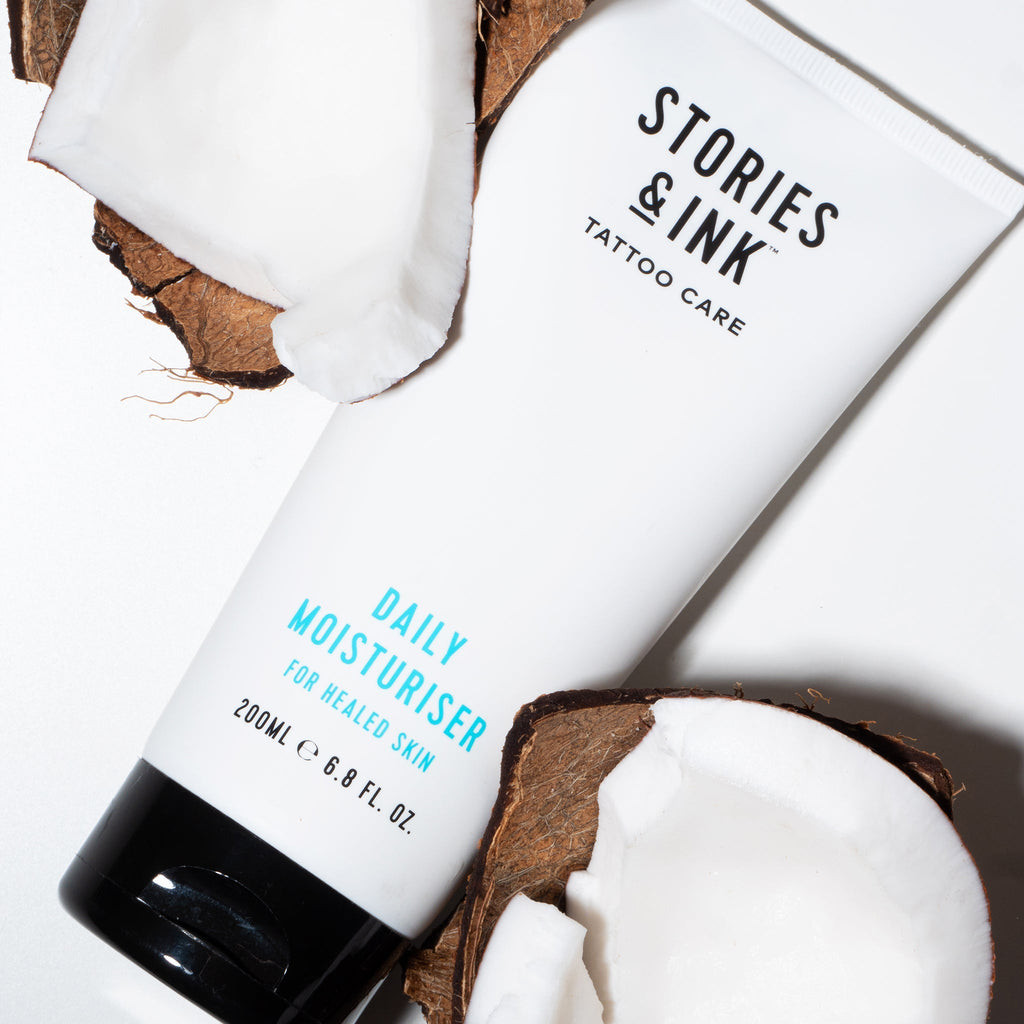What Spot Hurts The Least For A Tattoo? If you’re venturing into the world of tattoos, understanding pain levels is key. At tattooat.com, we believe getting inked should be a memorable and empowering experience, not one filled with unnecessary dread. Discover the least painful spots for tattoos and embark on your body art journey with confidence. Plus, explore tattoo placement ideas, pain management tips, and how to connect with skilled tattoo artists.
1. Where Are The Least Painful Places To Get A Tattoo?
The least painful places to get a tattoo tend to be areas where the skin is thicker, there are fewer nerve endings, and there’s a good amount of fat underneath. This includes areas such as the forearms, outer upper arms, and outer thighs. These spots offer a more comfortable experience compared to areas with thin skin or numerous nerve endings.
Tattoo pain is subjective, but some areas generally cause less discomfort. These areas usually have fewer nerve endings and more fat, acting as a cushion. The following spots are often cited as the least painful for tattoos:
- Forearms: The top choice due to thick skin and fewer nerve endings.
- Outer Upper Arms: Similar to forearms, offering a comfortable experience.
- Outer Shoulders: A fleshy area with fewer nerve endings.
- Outer Upper Thighs: Plenty of fat and muscle make this a good choice.
- Calves: More muscle and fewer nerves than other leg areas.
- Lower Back: Thick skin and fewer nerve endings in this region.
If you’re new to tattoos, starting with one of these spots can help ease you into the experience.
 Forearm tattoos
Forearm tattoos
Tattoo designs on the forearm, known for being one of the least painful areas. Tattoos on @barbaradzerve.
2. What Factors Influence Tattoo Pain Levels?
Tattoo pain varies for many reasons, including age, gender, tattoo technique, and personal expectations. Recognizing these factors helps you prepare for a more comfortable experience. According to research from Portland State University’s Art Department, in July 2025, individual pain tolerance significantly impacts the perceived pain during tattooing.
Several elements influence how painful a tattoo feels:
- Age: Some studies suggest pain sensitivity decreases with age.
- Biological Sex: There’s evidence women might experience pain more intensely.
- Tattoo Technique: Fineline tattoos may be less painful than traditional bold designs.
- Time Being Tattooed: Shorter sessions are generally less painful.
- The Tattoo Artist: A gentle artist can make a big difference.
- Personal Expectations: A positive mindset can reduce perceived pain.
- Overall Health: Being well-rested and fed can improve your pain tolerance.
2.1 Does Age Affect Tattoo Pain?
Some studies suggest that pain sensitivity decreases as you age. However, personal experiences vary. If you’re older, you might find it harder to sit for long tattoo sessions.
2.2 Does Biological Sex Impact Tattoo Pain?
There is some evidence suggesting that people who are biologically female “experience greater pain intensity, lower thresholds, and lower tolerance to experimentally induced pain.” However, more research is needed to confirm this. Menstruation can also affect pain tolerance due to hormonal changes.
2.3 How Does Tattoo Technique Influence Pain?
The tattoo style affects pain levels. Traditional bold tattoos might hurt more than fineline work. Hand-poked tattoos are often considered gentler.
2.4 Why Does The Duration Of The Tattoo Session Matter?
Small tattoos are less painful because they take less time. Longer sessions cause more trauma and irritation to the skin. Your sitting position can also become uncomfortable, increasing pain.
2.5 How Does The Tattoo Artist’s Technique Affect Pain?
The tattoo artist’s skill can influence pain. Some artists are heavy-handed or wipe the tattoo excessively.
2.6 How Do Expectations Influence Tattoo Pain?
Your expectations can affect how painful you find the tattoo. If you expect it to be extremely painful, it likely will be.
2.7 How Does Overall Health On The Day Affect Tattoo Pain?
If you’re stressed, haven’t eaten, or are rushed, the tattoo will feel more intense. Being well-rested and having a good meal beforehand can improve your pain tolerance.
2.8 What About Tattooing Over Scars Or Stretch Marks?
Tattooing over scars depends on the scar’s depth and size. Stretch marks can be more sensitive, making these areas more painful.
2.9 Are Cover-Up Tattoos More Painful?
Cover-up tattoos, done over old tattoos, might be more painful if the skin is scarred. However, experiences vary.
 Upper arm tattoos
Upper arm tattoos
Upper arm tattoos are often less painful due to the cushioning effect of muscle and fat.
3. Where Is The Least Painful Place To Get A Tattoo For A Woman?
The least painful places for women to get a tattoo are areas with fewer nerve endings and thicker skin, such as the outer shoulders or upper thighs. These spots provide a more comfortable tattooing experience.
4. Where Is The Least Painful Place To Get A Tattoo For A Man?
The least painful place for men is usually on the arm, particularly the forearm or outer upper arm. This makes these areas ideal for half or full sleeve tattoos.
5. How Can You Prepare For A Tattoo To Minimize Pain?
Preparation is key to minimizing tattoo pain. Hydrate well, avoid alcohol, and get enough sleep before your appointment. Using a daily moisturizer, like Stories & Ink’s Daily Moisturiser, can also help prepare your skin. Just don’t use it on the day of your appointment, as it can prevent the stencil from sticking.
To minimize pain, consider these tips:
- Stay Hydrated: Drink plenty of water in the days leading up to your appointment.
- Avoid Alcohol: Alcohol can thin your blood and increase sensitivity.
- Get Enough Sleep: Being well-rested improves your pain tolerance.
- Eat a Good Meal: A full stomach helps stabilize your blood sugar levels.
- Moisturize Your Skin: Healthy, hydrated skin is easier to tattoo.
- Consider Numbing Creams: Consult your artist about safe options.
- Relax and Breathe: Stay calm and focused during the session.
Proper preparation significantly reduces discomfort.
6. Tattoo Pain Chart: Understanding Pain Levels by Body Part
| Body Part | Pain Level | Description |
|---|---|---|
| Forearm | Low | Thick skin, fewer nerve endings |
| Outer Upper Arm | Low | Good amount of muscle and fat |
| Outer Shoulder | Low | Fleshy area with fewer nerve endings |
| Outer Upper Thigh | Low | Plenty of fat and muscle |
| Calves | Low | More muscle and fewer nerves compared to other leg areas |
| Lower Back | Low | Thick skin and fewer nerve endings |
| Upper Back | Medium | More nerve endings than lower back |
| Inner Arm | Medium | Thinner skin, closer to bone |
| Upper Thigh (Inner) | Medium | More sensitive than outer thigh |
| Stomach | Medium | Can be sensitive due to nerve endings and skin elasticity |
| Buttocks | Medium | More fat, but still can be sensitive |
| Chest | High | Thin skin, close to bone, many nerve endings |
| Ribs | High | Thin skin, directly over bone |
| Armpit | High | Very sensitive due to many nerve endings |
| Groin | High | High concentration of nerve endings |
| Knees | High | Bony area with thin skin |
| Elbows | High | Bony area with thin skin |
| Ankles | High | Thin skin, close to bone |
| Feet | High | Thin skin, many nerve endings |
| Hands | High | Thin skin, close to bone, many nerve endings |
| Neck | High | Sensitive area with many nerve endings |
| Spine | High | Directly over bone, many nerve endings |
| Head/Face | High | Thin skin, close to bone, many nerve endings |
This chart offers a general guideline, but individual experiences can vary.
7. What Are Some Common Misconceptions About Tattoo Pain?
Many myths surround tattoo pain. One common misconception is that all tattoos hurt the same. Another is that numbing creams don’t work. Understanding the reality helps manage expectations.
Common myths include:
- All tattoos hurt the same: Pain varies by location and individual tolerance.
- Numbing creams don’t work: Some creams can be effective if used correctly.
- Men have a higher pain tolerance: Pain tolerance is individual, not gender-based.
- Thin people feel more pain: Body fat can cushion some areas, but it’s not the only factor.
- Black tattoos hurt more: Color doesn’t affect pain levels.
8. Can Numbing Creams Really Reduce Tattoo Pain?
Yes, numbing creams can help reduce tattoo pain. These creams typically contain lidocaine, which temporarily numbs the skin. Consult your tattoo artist before using any numbing cream to ensure it’s safe and won’t affect the tattoo process.
9. What Aftercare Steps Can Help With Tattoo Discomfort?
Proper aftercare can alleviate discomfort. Keep the area clean and moisturized, and follow your artist’s instructions. Tattoo aftercare products, like those from Stories & Ink, are also helpful.
Essential aftercare steps:
- Keep it Clean: Gently wash the tattoo with mild soap and water.
- Moisturize: Apply a thin layer of tattoo-specific moisturizer.
- Avoid Sun Exposure: Protect the tattoo from direct sunlight.
- Don’t Pick or Scratch: Let the tattoo heal naturally.
- Stay Hydrated: Drinking water helps with skin healing.
- Wear Loose Clothing: Avoid tight clothing that can irritate the tattoo.
10. How To Find The Right Tattoo Artist For A Comfortable Experience?
Finding a skilled and gentle tattoo artist is crucial. Read reviews, check portfolios, and talk to the artist about your concerns. A good artist will prioritize your comfort.
Tips for finding the right artist:
- Read Reviews: See what other clients say about their experience.
- Check Portfolios: Ensure the artist’s style matches your vision.
- Ask Questions: Discuss your concerns and expectations.
- Look for Cleanliness: A sterile environment is essential.
- Trust Your Gut: Choose an artist you feel comfortable with.
A skilled artist can make the process much smoother.
 Thigh tattoo
Thigh tattoo
Thigh tattoos, particularly on the outer thigh, are known for being less painful due to more muscle and fat.
11. What Are Some Alternative Ways To Manage Tattoo Pain?
Beyond numbing creams, alternative pain management techniques include deep breathing, meditation, and distraction. These methods can help you relax and cope with the discomfort.
Consider these options:
- Deep Breathing: Focus on slow, deep breaths to calm your nerves.
- Meditation: Practice mindfulness to reduce anxiety.
- Distraction: Listen to music, watch a movie, or chat with your artist.
- Hypnosis: Some people find hypnosis helpful for pain management.
- Acupuncture: A few sessions before the tattoo can reduce sensitivity.
12. Why Tattooat.com Is Your Go-To Resource For Tattoo Information
At tattooat.com, we offer a comprehensive resource for all things tattoos. From design inspiration to artist recommendations and aftercare tips, we’re here to guide you through every step of your tattoo journey. Explore our extensive collection of tattoo designs, find talented artists in your area, and read detailed guides on tattoo preparation and aftercare.
FAQ: Common Questions About Tattoo Pain
12.1 Does Getting A Tattoo On Bone Hurt More?
Yes, tattoos over bone generally hurt more because there’s less tissue to cushion the needle.
12.2 Are Rib Tattoos Really That Painful?
Yes, rib tattoos are known to be very painful due to thin skin and proximity to bone.
12.3 Do Color Tattoos Hurt More Than Black Ink Tattoos?
No, the color of the ink doesn’t affect the pain level. The technique and location are the primary factors.
12.4 Can I Drink Alcohol To Numb The Pain Before A Tattoo?
No, drinking alcohol is not recommended. It thins the blood and can increase bleeding and sensitivity.
12.5 How Long Does Tattoo Pain Typically Last?
The initial pain lasts during the tattoo session. After that, you may experience soreness for a few days.
12.6 Is It Okay To Take Painkillers Before Getting A Tattoo?
Consult your tattoo artist before taking any painkillers. Some can thin the blood and affect the process.
12.7 How Can I Tell If My Tattoo Is Infected?
Signs of infection include excessive redness, swelling, pus, and fever. See a doctor immediately if you suspect an infection.
12.8 What Should I Wear To My Tattoo Appointment?
Wear loose, comfortable clothing that allows easy access to the area being tattooed.
12.9 Can I Get A Tattoo If I Have Sensitive Skin?
Yes, but discuss your skin sensitivity with your artist. They can adjust their technique and use hypoallergenic inks.
12.10 How Soon After Getting A Tattoo Can I Exercise?
Avoid strenuous exercise for at least a week to allow the tattoo to heal properly.
Before you get tattooed, we recommend using our Daily Moisturiser. It will help prepare your skin with nourishing ingredients. We also recommend looking at our tattoo aftercare products to assist in healing your new tattoo.
 Stories & Ink Daily Moisturiser
Stories & Ink Daily Moisturiser
Hydrate and nourish your skin with Stories & Ink’s Daily Moisturiser.
Ready to explore the world of tattoos? Visit tattooat.com to discover stunning designs, find talented artists, and learn everything you need to know about tattoo culture and care.
Address: 1825 SW Broadway, Portland, OR 97201, United States.
Phone: +1 (503) 725-3000.
Website: tattooat.com.
Find the perfect design, connect with a skilled artist, and embrace the art of tattooing with confidence. Start your tattoo journey with tattooat.com today and bring your vision to life.
